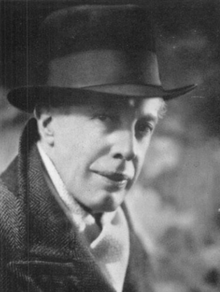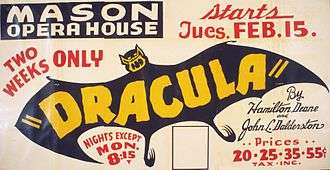Hamilton Deane
Hamilton Deane (1880–1958) was an Irish actor, playwright and director. He played a key role in popularising Bram Stoker's 1897 novel Dracula as a 1924 stage play and a 1931 film.[1]
Hamilton Deane | |
|---|---|
 Deane in 1939 | |
| Born | 1880 New Ross, Ireland |
| Died | 25 October 1958 London, England |
| Occupation | Actor, Playwright, director |
| Nationality | Irish |
Life
Deane was born in New Ross in County Wexford, Ireland, and grew up in Clontarf, a suburb of Dublin.[2] His family lived close to the families of both Bram Stoker and Florence Balcombe (Stoker's wife), and his mother had been acquainted with Bram Stoker in her youth.[3]
Deane entered the theater as a young man, first appearing in 1899 with the Henry Irving Company (Stoker was stage manager for Henry Irving for many years). Even before he formed his own troupe in the early 1920s, Deane had been thinking about bringing Dracula to the stage. Stoker had attempted this in 1897 but the verdict from Irving consigned it to the waste-paper basket. Unable to find a scriptwriter to take on the project, Deane wrote the play himself in a four-week period of inactivity while he was suffering with a severe cold. He then contacted Florence Stoker, Bram's widow, and negotiated a deal for the dramatic rights.[4]
Deane re-imagined Count Dracula as a more urbane and theatrically acceptable character who could plausibly enter London society. It was Deane's idea that the count should wear a tuxedo and stand-up collar, and a flowing cape which concealed Dracula while he slipped through a trap-door in the stage floor, giving the impression that he had disappeared.[5] Deane also arranged to have a uniformed nurse available at performances, ready to administer smelling salts should anyone faint.

Deane's play premiered at the Grand Theatre, Derby in June 1924.[6] Despite critics' misgivings, the audiences loved it. With Raymond Huntley as the Count and Deane as Van Helsing, it was a huge success and toured for years.[7] Deane had initially intended to play the role of the count himself.[6] When the play crossed the Atlantic in 1927, the role of Dracula was taken by the then-unknown Hungarian actor Béla Lugosi. For its US debut, Dracula was rewritten by the American playwright John L. Balderston. The show ran for a year on Broadway and for two more years on tour, breaking all previous records for any show put on tour in the United States.[4] It is the Deane/Balderston interpretation upon which the classic Tod Browning film Dracula (1931) was based.[1]
Works
- Deane, Hamilton, and John L. Balderston. Dracula: The Vampire Play in Three Acts. New York: Samuel French, 1927.
See also
References
- Why Dracula never loses his bite
- Looby, David (25 October 2016). "Fangs for the Memories!". New Ross Standard. Retrieved 15 October 2015.
- Skal (1990) p. 22
- Raymond T. McNally, Radu Florescu: In Search of Dracula. Haughton Mifflin Harcourt, 1994. p. 157
- Skal (1990) p. 73
- Skal (1990) p. 70
- James Craig Holte: Dracula in the Dark. Greenwood, 1997. p. 35
Cited text
- Hollywood Gothic: The Tangled Web of Dracula from Novel to Stage to Screen. New York: W. W. Norton & Company, 1990. ISBN 0-233-98766-5
Bibliography
- Dracula (The Original 1931 Shooting Script). Atlantic City, NJ: Magic Image Filmbooks, 1990.
- Glut, Donald F. The Dracula Book. Metuchen, NJ: Scarecrow Press, 1975.
- Skal, David J., ed. Dracula: The Ultimate, Illustrated Edition of the World-Famous Vampire Play. New York: St. Martin's Press, 1993.